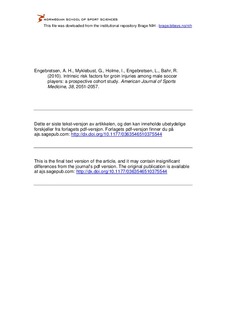| dc.contributor.author | Engebretsen, Anders Hauge | |
| dc.contributor.author | Myklebust, Grethe | |
| dc.contributor.author | Holme, Ingar Morten K. | |
| dc.contributor.author | Engebretsen, Lars | |
| dc.contributor.author | Bahr, Roald | |
| dc.date.accessioned | 2011-08-18T11:08:45Z | |
| dc.date.available | 2011-08-18T11:08:45Z | |
| dc.date.issued | 2010-08-10 | |
| dc.identifier | Seksjon for idrettsmedisinske fag / Department of Sports Medicine | |
| dc.identifier.citation | American Journal of Sports Medicine. 2010, 38(10), 2051-2057 | en_US |
| dc.identifier.issn | 0363-5465 | |
| dc.identifier.uri | http://hdl.handle.net/11250/170873 | |
| dc.description | I Brage finner du siste tekst-versjon av artikkelen, og den kan inneholde ubetydelige forskjeller fra forlagets pdf-versjon. Forlagets pdf-versjon finner du på
ajs.sagepub.com: http://dx.doi.org/10.1177/0363546510375544 / In Brage you'll find the final text version of the article, and it may contain insignificant differences from the journal's pdf version The original publication is available at ajs.sagepub.com: http://dx.doi.org/10.1177/0363546510375544 | en_US |
| dc.description.abstract | BACKGROUND: This study was conducted to determine if risk factors for groin injuries among male soccer players could be identified.
HYPOTHESIS: Previous groin injuries, reduced function scores, age, findings on clinical examination, and low isometric groin strength are associated with increased risk of new groin injuries.
STUDY DESIGN: Cohort study; Level of evidence, 3.
METHODS: A total of 508 players representing 31 amateur teams were tested during the 2004 preseason for potential risk factors for groin injury through a questionnaire on previous injury and function score (Groin Outcome Score [GrOS]) and a clinical examination of the groin. Generalized estimating equations were used in univariate analyses to identify candidate risk factors, and factors with a P value <.10 were then examined in a multivariate model.
RESULTS: During the soccer season, 61 groin injuries affecting 55 legs (51 players) were registered. The total incidence of groin injuries was 0.6 injuries per 1000 playing hours (95% confidence interval [CI], 0.4-0.7), 0.3 injuries per 1000 training hours (95% CI, 0.2-0.4), and 1.8 injuries per 1000 match hours (95% CI, 1.2-2.5). In a multivariate analysis, previous acute groin injury (adjusted odds ratio [OR], 2.60; 95% CI, 1.10-6.11) and weak adductor muscles as determined clinically (adjusted OR, 4.28; 95% CI, 1.31-14.0) were significantly associated with increased risk of groin injuries. A multivariate analysis based only on acute time-loss injuries revealed the 40-m sprint test result (adjusted OR, 2.03 for 1 standard deviation change [injured group faster]; 95% CI, 1.06-3.88; P = .03) and functional testing of the rectal abdominal muscles (adjusted OR, 15.5 [painful in 19% of the players in the injured group compared to 16% in the uninjured group]; 95% CI, 1.11-217; P = .04) as significant risk factors.
CONCLUSION: A history of acute groin injury and weak adductor muscles are significant risk factors for new groin injuries. | en_US |
| dc.language.iso | eng | en_US |
| dc.publisher | SAGE | en_US |
| dc.subject | athletic injuries | en_US |
| dc.subject | cohort studies | en_US |
| dc.subject | groin injuries | en_US |
| dc.subject | humans | en_US |
| dc.subject | male | en_US |
| dc.subject | Norway | en_US |
| dc.subject | prospective studies | en_US |
| dc.subject | questionnaires | en_US |
| dc.subject | risk assessment | en_US |
| dc.subject | risk factors | en_US |
| dc.subject | soccer injuries | en_US |
| dc.subject | etiology | |
| dc.title | Intrinsic risk factors for groin injuries among male soccer players : a prospective cohort study | en_US |
| dc.type | Journal article | en_US |
| dc.type | Peer reviewed | en_US |
| dc.subject.nsi | VDP::Social science: 200::Social science in sports: 330 | en_US |
| dc.subject.nsi | VDP::Medical disciplines: 700::Clinical medical disciplines: 750 | en_US |
| dc.subject.nsi | VDP::Medical disciplines: 700::Sports medicine: 850 | en_US |
| dc.source.pagenumber | 2051-2057 | en_US |
